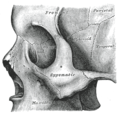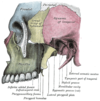
Zygomatic process
Encyclopedia

Human skull
The human skull is a bony structure, skeleton, that is in the human head and which supports the structures of the face and forms a cavity for the brain.In humans, the adult skull is normally made up of 22 bones...
, like the bumper of a car. Most of it belongs to the zygomatic bone
Zygomatic bone
The zygomatic bone is a paired bone of the human skull. It articulates with the maxilla, the temporal bone, the sphenoid bone and the frontal bone. The zygomatic is homologous to the jugal bone of other tetrapods...
, and could therefore be called the zygomatic process of the zygomatic bone. However, there are other bones contributing to it too, namely the frontal bone
Frontal bone
The frontal bone is a bone in the human skull that resembles a cockleshell in form, and consists of two portions:* a vertical portion, the squama frontalis, corresponding with the region of the forehead....
, maxilla
Maxilla
The maxilla is a fusion of two bones along the palatal fissure that form the upper jaw. This is similar to the mandible , which is also a fusion of two halves at the mental symphysis. Sometimes The maxilla (plural: maxillae) is a fusion of two bones along the palatal fissure that form the upper...
and temporal bone
Temporal bone
The temporal bones are situated at the sides and base of the skull, and lateral to the temporal lobes of the cerebrum.The temporal bone supports that part of the face known as the temple.-Parts:The temporal bone consists of four parts:* Squama temporalis...
, which therefore form:
- Zygomatic process of frontal boneZygomatic process of frontal boneThe zygomatic process of frontal bone is the part of the zygomatic process consisting of the frontal bone.The supraorbital margin of the frontal bone ends laterally in the zygomatic process, which is strong and prominent, and articulates with the zygomatic bone...
- Zygomatic process of maxillaZygomatic process of maxillaThe zygomatic process of the maxilla is a rough triangular eminence, situated at the angle of separation of the anterior, zygomatic, and orbital surfaces.* In front it forms part of the anterior surface....
- Zygomatic process of temporal boneZygomatic process of temporal boneThe zygomatic process of the temporal bone is a long, arched process projecting from the lower part of the squamous portion of the temporal bone...
The term zygomatic derives from the Greek Ζυγόμα zygoma meaning "yoke". The zygomatic process is occasionally referred to as the zygoma
Zygoma
The term zygoma generally refers to the zygomatic bone, a bone of the human skull commonly referred to as the cheekbone or malar bone, but it may also refer to:...
, but this term usually refers to the zygomatic bone or occasionally the zygomatic arch
Zygomatic arch
The zygomatic arch or cheek bone is formed by the zygomatic process of temporal bone and the temporal process of the zygomatic bone , the two being united by an oblique suture; the tendon of the Temporalis passes medial to the arch to gain insertion into the coronoid process...
.
Processes
The zygomatic process is actually the entity of several processProcess (anatomy)
In anatomy, a process is a projection or outgrowth of tissue from a larger body. The vertebra has several kinds of processes,such as: transverse process, prezygapophysis, postzygapophysis.-Examples:Examples of processes include:...
es, namely the frontosphenoidal, orbital, maxillary and temporal processes.
The frontosphenoidal process is thick and serrated. The cranial suture between the
frontal and zygomatic bone is found here. On its orbital surface, just within the orbital margin and about 11 mm below the zygomaticofrontal suture is a tubercle of varying size and form, but present in 95 per cent of skulls (Whitnall 43). This tubercle isn't seen in the picture.

The maxillary process presents a rough, triangular surface which articulates with the maxilla. It is the area below "zygomatic" in the image.
The temporal process, long, narrow, and serrated, articulates with the zygomatic process of the temporal. It is the process to the right of "zygomatic" in the image.

